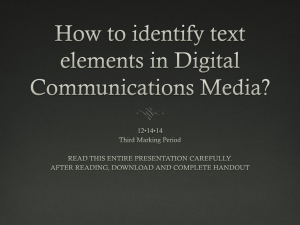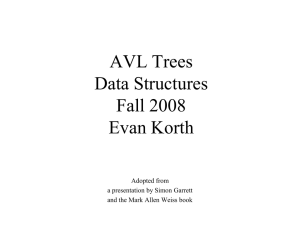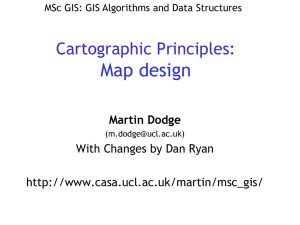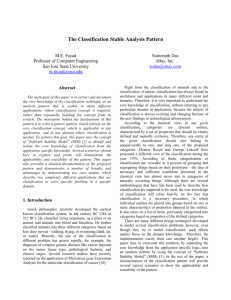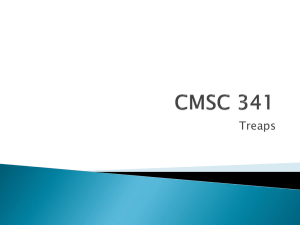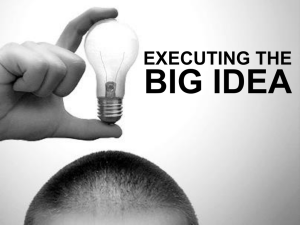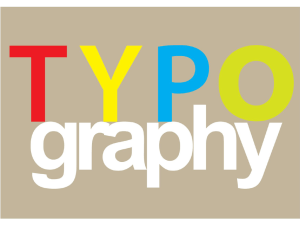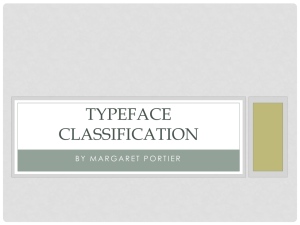AnyType: Provoking Reflection and Exploration with Aesthetic
advertisement
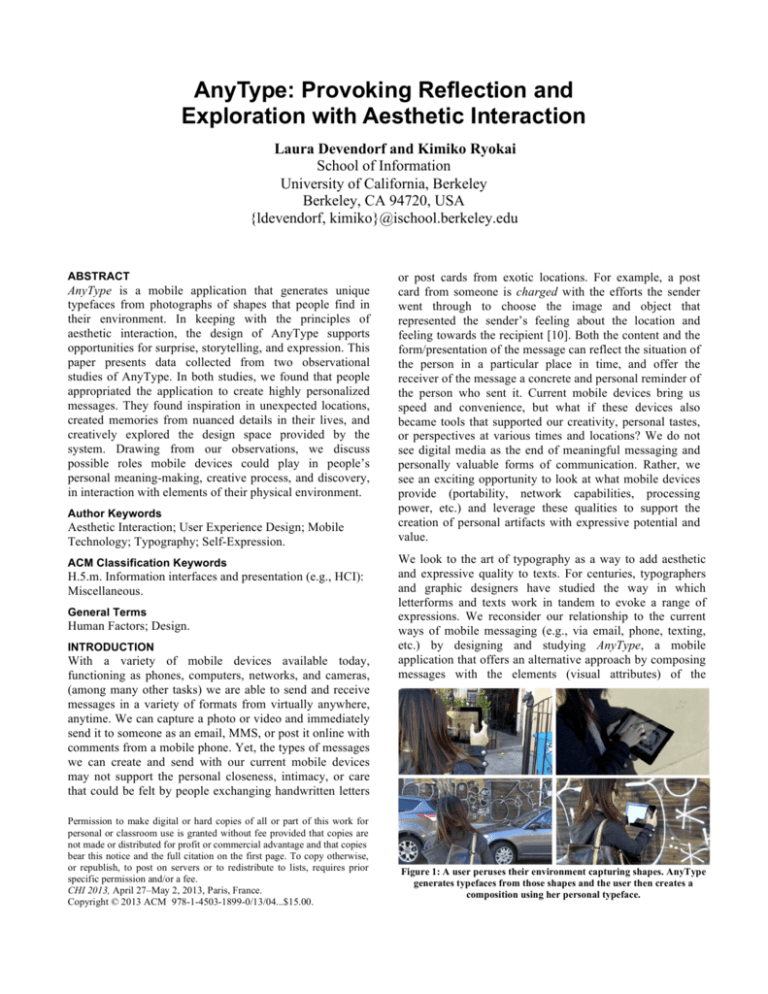
AnyType: Provoking Reflection and
Exploration with Aesthetic Interaction
Laura Devendorf and Kimiko Ryokai
School of Information
University of California, Berkeley
Berkeley, CA 94720, USA
{ldevendorf, kimiko}@ischool.berkeley.edu
ABSTRACT
AnyType is a mobile application that generates unique
typefaces from photographs of shapes that people find in
their environment. In keeping with the principles of
aesthetic interaction, the design of AnyType supports
opportunities for surprise, storytelling, and expression. This
paper presents data collected from two observational
studies of AnyType. In both studies, we found that people
appropriated the application to create highly personalized
messages. They found inspiration in unexpected locations,
created memories from nuanced details in their lives, and
creatively explored the design space provided by the
system. Drawing from our observations, we discuss
possible roles mobile devices could play in people’s
personal meaning-making, creative process, and discovery,
in interaction with elements of their physical environment.
Author Keywords
Aesthetic Interaction; User Experience Design; Mobile
Technology; Typography; Self-Expression.
ACM Classification Keywords
H.5.m. Information interfaces and presentation (e.g., HCI):
Miscellaneous.
General Terms
Human Factors; Design.
INTRODUCTION
With a variety of mobile devices available today,
functioning as phones, computers, networks, and cameras,
(among many other tasks) we are able to send and receive
messages in a variety of formats from virtually anywhere,
anytime. We can capture a photo or video and immediately
send it to someone as an email, MMS, or post it online with
comments from a mobile phone. Yet, the types of messages
we can create and send with our current mobile devices
may not support the personal closeness, intimacy, or care
that could be felt by people exchanging handwritten letters
Permission to make digital or hard copies of all or part of this work for
personal or classroom use is granted without fee provided that copies are
not made or distributed for profit or commercial advantage and that copies
bear this notice and the full citation on the first page. To copy otherwise,
or republish, to post on servers or to redistribute to lists, requires prior
specific permission and/or a fee.
CHI 2013, April 27–May 2, 2013, Paris, France.
Copyright © 2013 ACM 978-1-4503-1899-0/13/04...$15.00.
or post cards from exotic locations. For example, a post
card from someone is charged with the efforts the sender
went through to choose the image and object that
represented the sender’s feeling about the location and
feeling towards the recipient [10]. Both the content and the
form/presentation of the message can reflect the situation of
the person in a particular place in time, and offer the
receiver of the message a concrete and personal reminder of
the person who sent it. Current mobile devices bring us
speed and convenience, but what if these devices also
became tools that supported our creativity, personal tastes,
or perspectives at various times and locations? We do not
see digital media as the end of meaningful messaging and
personally valuable forms of communication. Rather, we
see an exciting opportunity to look at what mobile devices
provide (portability, network capabilities, processing
power, etc.) and leverage these qualities to support the
creation of personal artifacts with expressive potential and
value.
We look to the art of typography as a way to add aesthetic
and expressive quality to texts. For centuries, typographers
and graphic designers have studied the way in which
letterforms and texts work in tandem to evoke a range of
expressions. We reconsider our relationship to the current
ways of mobile messaging (e.g., via email, phone, texting,
etc.) by designing and studying AnyType, a mobile
application that offers an alternative approach by composing
messages with the elements (visual attributes) of the
Figure 1: A user peruses their environment capturing shapes. AnyType
generates typefaces from those shapes and the user then creates a
composition using her personal typeface.
environment in which the user may be immersed. AnyType
provides a process through which people can build and
create messages using their own personal typefaces. By
navigating, identifying, and capturing characteristic shapes
in their environment, people create typefaces and messages
that are situated in time and space, which function as objects
of reflection.
Using AnyType, we explore aesthetics of composition that
people may experience in everyday mobile contexts. This is
not meant as an investigation of an individual’s ability to
create beautiful compositions (i.e., symmetry, balance, etc.)
on the go. Rather, we explore what happens if we give
people an opportunity to create typefaces and capture more
than text or photos. What becomes meaningful, beautiful, or
interesting to people? What becomes worth saving or sharing
across the spectrum of contexts in which they might find
themselves?
We present results from our study with 26 people: 16 using
AnyType for a short period (1-2 hours) and 10 using
AnyType on their own for 1 week. We describe how people
captured and transformed elements in their environment
into personally meaningful messages that embodied their
thoughts, feelings, and experiences. By drawing from
principles of aesthetic interactions [2,6,17], we discuss the
potential role mobile devices could play in personal
meaning-making, creative process, and discovery, as they
interact with elements of the physical environment.
BACKGROUND
Aesthetics of Interaction
Aesthetics of interaction is a growing topic within HCI
research. The term aesthetics of interaction has been used
among design researchers to connote eliciting enjoyment,
beauty, or pleasure in interaction; in other words, systems
that are “beautiful in use” [12]. The goal of aesthetic
interaction is to go beyond usability and usefulness,
promoting curiosity, engagement, and imagination in the
exploration of an interactive system [17]. Research into the
aesthetics of interaction concerns experiences that may be
“challenging, seductive, playful, surprising, memorable, or
rewarding,” all of which can “result in enjoyment of
experience” [12].
Boehner et al. [2] argue, “If the aesthetic experience is by
nature irreducible, then we should design, code, and
evaluate systems in ways that do not primarily reduce
complexity and reify abstract categories of practice.”
Therefore, aesthetic experience is also bound by the
ineffable—indescribable and irreducible aspects of being
[6].
Further, McCarthy et al. argue for considering enchantment
in design, i.e. supporting depth of engagement and allowing
for surprise that can lead to—as opposed to script or
control—rich experiences [16]. McCarthy et al. note,
‘‘enchantment does not necessarily imply that the object of
enchantment must be novel or extraordinary, rather that the
person sees how rich and extraordinary the everyday and
familiar can be.’’ [16] Enchantment is a way of thinking
about and designing for depth in an interactive experience.
McCarthy et al. describe how experience may become
enchanting or enlightening through interaction with socalled “attentive objects," objects that “can convey
interesting information to people that they would never
have bothered to look up in the first place, thereby turning
every moment into a learning opportunity” [16]. AnyType
is our attempt at designing such an attentive object for
composing messages in mobile contexts.
Related Technologies
The limits and possibilities of communication technologies
continue to be a prolific area for HCI and computer
mediated communication design research. Many
researchers develop and study experimental interfaces that
explore how the ineffable may be communicated over
distance through new digital media [6,19]. For example,
SenseMS is an enhanced SMS application designed to
support affective communication among teens [1]. With
SenseMS teens designed special “stamps” that could be
attached to the SMS messages, in which the location and
mood of the sender were embodied.
Postcrossing investigates the relationship between physical
and digital communications through an online system that
facilitates the sending of physical post-cards between
strangers [14]. It suggests ways in which digital
communication tools could provoke and facilitate
experiences of personalization, anticipation, and surprise
resembling those of pre-digital formats. AnyType builds on
the ideas presented in Postcrossing as we investigate and
present results for how meaning and value are constructed
through experience with digital communications.
In the past, several projects explored the expressive
potential of typography. Many of these projects look to
kinetic typography as a way for digital texts to convey more
emotional and expressive qualities [4,13,16,19]. Our
approach is different. In AnyType, expressive potential is
located in the experience of creating messages, not added to
an existing message. We also believe that images can
express emotion and feelings in a similar way to movement
when embedded within letterforms.
ANYTYPE
“Letterforms that honor and elucidate what humans see and
say deserve to be honored in their turn. Well-chosen words
deserve well-chosen letters.”
– Bringhust (2004)
Until the digital age, typography was a specialized
occupation, but with the proliferation of digital tools
“typography is now something everybody does” [13]. Yet
the art of typography is not just about using pretty
typefaces. As a type designer Matthew Carter said, “Type is
a beautiful group of letters, not a group of beautiful letters.”
Considering the art of typography and our increased access
to digital compositional tools in mobile contexts, we see an
opportunity to support surprise, engagement, and discovery
through the ability to create typographic compositions that
literally incorporate elements from different spaces and
times.
Current Design
Capture
When a user launches the AnyType application, she sees
the camera view on the screen of her device. Unlike a
normal camera, AnyType places an overlay of a nontraditionally shaped frame (i.e., a narrow rectangle, arch, or
small square) onto the camera view, like a keyhole on the
screen (Figure 2A). The five shapes used are based on
conventional typographic forms and specifically mimic
those found in the typeface Helvetica. Each letter of the
English alphabet can be composed through an arrangement
of these five shapes (Figure 3).
A message on screen prompts the user to, “find something
that fits into this shape.” The user then looks through the
device in order to fit an object into the shaped frame shown
on her screen. When she finds something that fits into the
frame, she hits a capture button to save it and move to the
next shape. This process repeats four more times with a
new shaped frame superimposed on the camera view at
each step.
Typeface Generation and Composition
After capturing objects within the five shapes, AnyType
automatically creates each letter of the alphabet from the
five shapes the user identified and presents this alphabet to
the user in a row on the top of the screen (Figure 2D and
2E). This moment may come as a surprise, as it is the first
time the user sees all of her shapes automatically
transformed into different letterforms. The user can then
drag letters from her personal alphabet onto a canvas,
creating a composition. Her composition may take the form
of a message or graphical artwork composed of the
different letters. The user is given the ability to position,
scale, and erase letters from her canvas. At the press of a
button, the user can email her creation to others.
Video Mode
In video mode, the user captures up to 5 seconds of video in
addition to a photo for each shape. At the composition
phase, the user can add letters to the canvas and press a
letter to animate the video within it. Animations resemble
stop-motion animations and replay in sequence within the
letter. If the user captured a moving car within each of the
shapes, that car could be animated in such a way that the
car is driving along the letterform going from one shape to
the next. For instance, in the letter “V,” AnyType would
animate the left side of the “V” (the car would be seen
“driving” through the left side of the V) and then animate
the right side of the “V” (the car drives through the right
side).
History View
When the user or recipient presses and holds one of her
finished letters on the canvas, she is taken to the “history
view” that shows how the different shapes were arranged to
compose that letter. Clicking on one of the letter’s shapes
reveals the original photo or video from the point of
capture. This view is designed so that the user or recipient
of the composition can access a history of how each letter
was made. For instance, the user may capture a gear from a
bicycle in one of the arched shapes. Without added context
of the entire image of the bicycle, someone other than the
creator viewing the typeface might not be able to discern
Figure 2: A) The user looks onto her environment through a shaped frame and captures (photographs) an object in this shaped frame. B&C) After
capturing the shape, the user can edit by drawing a custom outline for the shape. D&E) After capturing all five shapes, the user is presented with
her personal alphabet in the composition mode. The letters can be dragged, scaled and erased with fingers. F) In the history view, the user can see
the original photographs that were used to compose each letterform.
what it is. The history view allows the creator to reveal this
context to others. This act of hiding and revealing where
images or videos came from adds an additional level of
storytelling and possible surprise between the creator and
the receiver. (Figure 2F)
Editing the Letter Shapes
During the capture phase, each of the five shapes can be
edited. Within the shape, the user can draw with her finger
to outline the contours of her captured object. For instance,
she might capture a tower with a pointed roof in the long
rectangle shape. She can use her finger to outline the tower
and its pointy roof in order to remove the background and
emphasize the pointy roof. The resulting shape looks as
though it was cut out with scissors. This editing can greatly
alter the look and feel of the resulting typeface. (Figure 2B,
2C)
ANYTYPE STUDY
How might the process of creating typefaces from one’s
environment using AnyType be translated into
compositions? How might the AnyType application
influence individuals’ relationship to their surroundings?
How might AnyType compositions be interpreted as a form
of communication? In order to observe how people
interpret AnyType and what type of compositions they
make in different contexts, we conducted both a short-term
study (1-2 hours) and a long-term study (one week) with
AnyType. Each study provided distinct insights into
different aspects of the system. In the short-term studies,
we focused on observing how people interact with the
system in order to gain insights about their initial reactions
to the AnyType application. Through the long-term studies,
we began to understand the ways in which AnyType was
used in the daily lives of our users.
The same version of the AnyType application was used in
both studies and all study participants were provided with a
tablet to use. To ensure that our study included both artists
and non-artists, we asked all participants to describe any
formal training or extensive experience they had in a visual
arts field.
In short-term studies, we collected data in the form of semistructured interviews and participant observation in order to
study how people engaged with the AnyType application.
In the long-term study, we incorporated projective
interview techniques using photo elicitation methods [9] by
asking each participant to describe each of their
compositions. This allowed us to gain insight into particular
motivations for each creation and provoked discussions
about participants’ lives and state of mind at moments in
which we could not be present. The data collected from
both studies provided us with nuanced descriptions of the
behaviors and thought processes engendered by
engagement with our system. We analyzed our field notes,
interview transcripts, and the compositions created by the
participants using the principles of Constructivist Grounded
Theory as outlined by Charmaz [8].
Figure 3: The five shapes used in the capture phase of AnyType are
arranged to create each letter of the English alphabet.
STUDY 1: INITIAL REACTIONS
Methods:
Participants
A total of 16 people with varying degrees of art experience
participated in the short-term study. 5 participants described
themselves as artists (have formal training, degrees or
significant job experience in visual art or design field), 2 as
hobby artists (practice art for fun but no formal training),
and 9 as non-artists (do not partake in any visual art
activities). Their ages ranged from 23 to 52 with a median
age of 28. All participants had used a touchscreen device
and 11 had used a device running the Android platform.
Procedures
The short studies lasted approximately 90 minutes. The
researcher met each participant at a mutually convenient
location (e.g., public parks, college campus, city streets).
During the study, the researcher video recorded each
participant as they traveled around capturing shapes for
their typefaces and made compositions from those
typefaces.
The researcher asked participants to create 5 compositions
using AnyType. Each time, they were asked to try a new
feature (e.g., basic mode, video mode, using the history
view). The researcher encouraged participants to “think
aloud” while using the application and occasionally asked
them to describe their reasoning (“I noticed you chose to
use video for this typeface, why?”) or how they felt about
what they were creating (“What do you think of this
typeface?”). Following the trials, the researcher interviewed
each participant about the experience.
Results
Reframing
As participants looked onto the world through shapeframes, they began to evaluate how objects in their
immediate environment might function as parts of their
typefaces. Looking at the brickwork laid into the cement,
Justin commented as he gestured toward the ground, “This
brick is boring and rectangular but it has new value in the
context of this app.”
This reframing changed the way individuals navigated their
environment. Many participants walked slowly as they
scanned their surroundings for interesting objects or
textures. In some cases, users began to notice new things in
familiar locations. Jane remarked, “I work in this building
everyday and I never realized that those railings were blue
or that this building has those reliefs outside.”
As they traversed their surroundings, participants let chance
inform their decisions about what elements to capture. In
some cases, this led them to be surprised when
juxtapositions of elements that they had not previously
considered formed interesting visual outcomes. Others used
chance to establish a theme for their typeface. For instance,
the movement of a fountain inspired a whole typeface on a
water theme and challenged the user to consider different
ways to represent water within the shapes.
Challenge
Some of the five shapes were harder to capture than others.
Participants found the task of fitting objects into arched
shapes particularly difficult. Melissa commented, “Every
time the 'U’s came up I was like, ‘Oh, what am I going to
do?’ That was difficult.” Many of the same participants
who expressed having difficulty in finding objects to fit
into shapes nevertheless remarked that they enjoyed using
the AnyType application. Difficulty was not a deterrent to
their experience in this context, but rather, navigating the
more difficult tasks became part of what made the
application interesting. Brian said, “This whole thing of
framing, that's one of the things that's really interesting
about it…. Like the ‘C’ shape, you don't always pay
attention to that. It really forces you to look through the
world with a different lens and that is really interesting. It's
basically being able to look at the world like little kids do.”
Composing Messages and Artworks with AnyType
After capturing their five shapes, participants were often
surprised to see the alphabet AnyType generated. Justin
mentioned enjoying “not knowing what was going to turn
out and being pleasantly surprised when something actually
turned out looking decent or funny.” Alex said, “I was
definitely not able to conceptualize how the images I had
taken would come together in the end to create the final
image—so that was a surprise every time. That was kind of
fun—like hey! That’s my typeface!” Participants were not
deterred by the possibility that some of their typefaces
might not come out as they had hoped. Instead, many saw
the application as a chance to experiment and let their
experience with one typeface, good or bad, guide the
decisions they made in capturing the next typeface.
With AnyType, the content of a message was not always
determined a priori but came from interactions with the
system. After being presented with their personal typeface,
most individuals began the composition phase by almost
randomly choosing letters and investigating how each
shape was constructed. Depending on what they captured,
they liked the way some letters looked more than others.
Often, their preferences of particular letters became a
contributing factor to the composition they created. Emma
described how she was “enchanted by the Z” and created a
graphical composition by clustering Z’s together.
Participants imagined a number of ways they would use
AnyType for communication. Using AnyType while
traveling seemed like an exciting possibility for many
Figure 4: Study participants capturing "c" shapes from clocks, frozen
yogurt, pipes, and video of movement while running down the street.
participants. Brian commented on how he imagined using
this in Paris, “…you could send somebody this sort of
postcard of a place, where all these typeface captures are all
the textures behind these iconic sites and places.”
We did not design the process of using AnyType to be a
quick way to make something aesthetically pleasing.
Rather, we looked to foster an aesthetic experience through
which people could re-interpret their surroundings to make
new kinds of compositions reflecting their feelings and
state of mind. The short-term observations began to give us
insight into how participants transformed their experiences
with AnyType into compositions. However, 90 minutes
was too short to observe how the creative process with
AnyType could be motivated by real occasions and
opportunities that might arise in a person’s life. This led us
to conduct the second study where people were invited to
use AnyType for one week.
STUDY 2: ANYTYPE OVER TIME
Methods
Participants
10 people participated in the long-term study. Their age
ranged from 18 to 57 with a median age of 28. Seven
participants were female and 3 male. Three described
themselves as artists, 3 hobbyists, and 4 non-artists. All
participants had previous experience using touch screen
devices and 4 had experience using the Android platform.
Procedure
Participants received the same introduction to the system as
in the short-term study. They received an Android tablet
with AnyType installed and were told they could take the
tablet wherever they went. They were asked to create at
least two typefaces a day, one video mode and one photo
mode. After the week passed, the participants were
interviewed for about an hour to share their stories about
their experience with AnyType and describe each typeface
and composition.
Results
Seven of the 10 participants created more than the
requested 14 typefaces (15-19 typefaces). Most of the
typefaces were accompanied by 1-2 compositions. Nine out
of 10 participants said that they would continue to use this
application in their everyday lives if they had it on their
phone or tablet. The following sections describe the
experiences of the participants and the compositions they
created with AnyType over one week.
Creating Memories
In contrast to the short-term study, the participants in the
long-term study could take AnyType to a variety of
locations. Therefore, many of the typefaces and the
messages written in those typefaces became reminders of
users' day-to-day activities and travels. For example, Donna
created typefaces on a weekend trip to a wine country by
capturing images from the road, the sky, and the grapevines
that characterize the region. Karen brought AnyType to a
football game and took pictures of the ticket stub, the team
lined up on the field, and the goal post. With these
elements, she made a composition spelling out the team
name on the canvas.
Jeff made a video typeface that captured the ending
sequence he finally reached in Minecraft and used the
canvas to write a word describing the sequence. He also
captured images of text from a grant proposal he had been
working on and used the texts as textures for his typeface.
Jeff said, “I guess I was trying to see this as how to capture
some aspect of the experience or do something interesting
with the texture and try to like evoke some emotion or
feeling with the elements that I was looking at.” The
researcher then asked if he felt like he was able to do that
and he responded, “Yeah surprisingly, if someone told me
that up front, I would have been pretty skeptical.”
Jeff felt the most confident in his ability to express
emotional qualities of a place in the creation of a typeface
he called Flower Power. In this typeface he captured
textures from the plants in his garden, such as close ups of
veins on leaves and the stalks of sunflowers. Jeff said, “I
think Flower Power is when I kind of realized, I could
imagine starting off a message about this with my garden
like ‘hey—here's my garden,’ but also it’s like this little
weird mixture of the serenity you have when you're dealing
with a garden in something that you're writing.” Jeff,
though initially skeptical, found himself creating memories
with AnyType that represented both physical and emotional
components of his life in a unique way.
Monica, a high school student, used AnyType to record two
typefaces based on her family’s restaurant. The first
typeface contains images of food preparation, from the
sauces in containers to the final dish on the table. In her
second typeface, she captured a video from the aprons of all
the women working in the restaurant. Each apron was made
of a different checkered or plaid-patterned fabric. Monica
captured short video clips of these fabrics moving around
as the women worked in the kitchen. She also captured
video from her own apron. In Monica’s typefaces, we see
how her experience with AnyType moved from capturing
objects that generally characterize a restaurant (food,
tablets, napkins) to a set of images that communicate the
essence of her lived-experience working there. The videos
of the aprons moving within the word “Delilah” (her
sister’s name) resemble an Impressionist painting in the
way that they capture the emotion and essence of a fleeting
moment.
In interaction with their immediate surroundings, people
found new sources of inspiration in the patterns, colors,
textures, and movements of their spaces. With AnyType,
they became engaged in the process of exploring the
creative possibilities of these elements, and saw how the
elements could be arranged into expressive media. As
participants continued to iterate and explore with AnyType,
they found new ways to capture and convey their emotions.
Since each participant looks at his or her environment in
unique ways and finds inspiration in different types of
objects, the typefaces were highly individualized. Unlike
the traditional photos or texts, memories created with
AnyType can simultaneously represent images of what
individuals are looking at and create words that describe
how they feel or what they are thinking while they capture
those images.
Creative Exploration
Both artists and non-artists used AnyType as a tool for
creative exploration. They asked themselves “what if”
questions relating to the ways in which textures and texts
could form unique messages or artistic compositions.
Some participants saw working with AnyType as a way to
reflect on other works of art that inspired them, and
explored reinterpreting the meanings of these works in the
context of the application. For example, Jeff wanted to,
“Write a short poem I like… Dorothy Parker's ‘Resume.’
The first line is ‘razors pain you.’ I had some razor blades
so I figured I’d make it out of that.” He had an idea to do
every line of the text (which he recited from memory) in a
different typeface that related to the text on that line. When
asked why he would want to do this, he said, “It's a poem
that I like and it's probably the first time I ever thought I
could take some aspect of that poem and maybe add or
change something about it in the typeface itself because I'm
not much of a poet… I’m just making an interesting
addition to it.”
For Jeff, AnyType gave him a way to add his mark to a
work of art he liked and to think about what it meant to
him. He explored ideas of how text and images could
complement each other and that allowed him to take
something he loved in one context and experience it in a
new context.
AnyType, in the context of creative exploration, is a system
in which users are inspired to reflect on past experiences
with art and create new experiences. Jeff noted a “calming
effect” that came from using the application. Sandra talked
about how she could “play with [AnyType] and recharge
my brain.” These meditative aspects of working through a
process are often absent from media that place priority in
efficiency and speed. These moments of creative
exploration can become valuable opportunities to generate
new thoughts, ideas, and ways of seeing the world.
Self Reflection
Participants described the experience of capturing and
creating typefaces as one that allowed them to reflect upon
their thoughts, values and lives in a similar fashion to how
one might keep a sketchbook, diary, or journal. For
example, Melissa created a composition using the word,
“pheelings” and said, “It is about the way, I guess, life sort
of changed now that I’m in college. More than the objects
being important, [with AnyType] I looked for patterns. The
text for it is feelings and I spelled with a ‘ph’ because I like
that word a lot. I used the shapes to say—to give different
feelings to it.” Melissa used the editing function to draw her
own shapes. She drew each shape in order to evocatively
connect the shape and the image within the shape to a kind
of feeling. She also found that she could use color as a way
to represent feelings and emotions saying, “There was this
bag I had that had this bright blue and orange pattern and
that seemed like excitement and like new things and
positive things but then I had a shirt that was black and red
and it’s kind of conflicted about things and not able to
consider things as much as if it were going at a more glacial
pace.”
Sandra created a composition with the words, “Where has
my life gone.” When describing the composition she said,
“I just feel like I'm at this odd place in my life right now, I
was on a Sunday walk, feeling melodramatic and I made
this. Something in my mind just seems a bit more
interesting when it's a typeface like this.”
Like keeping a journal, AnyType allowed Sandra to get her
feelings out of her mind and onto a canvas where she could
reflect on them in a different context.
Melissa, Sandra, and others found the experience of using
AnyType to be one that made them feel introspective. They
saw AnyType as a new lens through which to filter, sort
out, and think about their feelings. AnyType became a
reflective tool for them to generate a new perspective on
their feelings and emotions through creative exploration.
Finding Inspiration in Unexpected Locations
As the participants brought AnyType with them on their
daily journeys, they found themselves exploring the
Figure 5: 1) A typeface and composition Karen made on her commute
home. 2) Delight with the first composition led her to create the second
typeface from the bikes of other commuters. 3) Inspired by her bike
typeface from her commute, Karen created another composition of her
own bike when she reached home.
creative possibilities of locations they may not have
expected to become source of inspiration. Donna became
inspired while running errands at Costco, a supermarket,
capturing images of the people and products to compose the
message “Feed America.” Sam became inspired to create a
video typeface from his computer screen as the script he
was running generated quickly moving lines of text.
Karen found herself being inspired during her evening
commute on the subway (BART) and continued to ideate
on themes and ideas she had on her commute after she
arrived home (Figure 5). Karen described her initial
inspiration for the typeface on the train as, “Oh, I’m going
to get motion in some videos on BART—that’ll be cool—it
will have that weird, like, BART noise in the background
and it has like a lot of good angular things that I thought
would fit well in the boxes and then BART was totally
insane and totally packed and I actually really liked it—
because I got to be so weird—it was really fun.”
According to Karen, one idea led to another and she went
on to make more typefaces on the train. She described, “I
was on BART and having fun with [AnyType] so I took the
‘Bikes of BART’ picture… bikes were cool because they
have like a lot of the different shapes with the wheels which
is why I think I started gravitating towards them.”
The next day, Karen captured images from her own bike
and used the letterforms as graphical primitives to create a
picture of a bike (Figure 5.3). Her experience characterizes
a progression of ideas that many participants in the week
long studies experienced. Creativity no longer became tied
to a particular place with a set of objects but extended into
people’s lived environment, providing them with more
opportunities for creative inspiration.
Figure 6: Monica made this composition for her mother using all of
her mother's favorite things.
Creating Interactive Messages
People imagined a number of ways that AnyType could be
used for communication. Many of the participants wanted
to share their AnyType compositions on Facebook or their
personal webpages. Sandra talked about how she rarely
updates her Facebook page with news of her daily life but
she saw the compositions she made with AnyType as
something to share. She observed, “They’re different
because I made them.” Jeff wanted a chance to repost the
Dorothy Parker poem he loves, but felt it would be strange
to just post it out of nowhere. He felt like creating a new
typeface for the poem, and AnyType gave him an
opportunity to add his own personal mark and share it in a
new way. AnyType gave these users an opportunity to
make new kinds of digital objects, ones that they “owned”
and could be proud of. They felt a sense of authorship of
the works and were eager to share them as a reflection of
themselves.
Gift-giving
Participants created compositions for friends and loved
ones in the course of the week. Moms were the recipients of
two of the participants’ compositions. Monica used all of
her mother’s favorite things to create the typeface (Figure
6). She liked this typeface the best because she was able to
capture elements her mom would like, and felt that it came
together really nicely. She captured images of a Mexican
doll, a flower in a painting, the praying hands of the virgin
of Guadalupe, and other figurines, and used them to create
the words “My Mom is the Best.” In capturing each image,
Monica was reflecting on what she felt were important
things for her mom. The experience of capturing these
elements was a gesture of appreciation. They represented
more than a simple greeting because they also gave Monica
a way to reflect on her cultural identity and her relationship
with her mother.
Karen had a friend with a birthday during her one-week
with AnyType. She was out one night and got an idea to
create a video typeface for her friend Rachel. She recorded
a different person in the group of friends saying “Happy
Birthday Rachel,” in each of the 5 shapes. The typeface was
recorded in a crowded, loud, and dimly lit bar. Each video
begins with Karen’s voice shouting “Go!” signaling for the
person to begin his or her happy birthday message. Karen
used AnyType to orchestrate a series of actions and capture
them in a card for her friend. Her effort in putting the card
together is evident in her voice shouting “Go!” at the start
of each video. She presented the card to her friend who
laughed when she realized all the letters were composed of
“happy birthday” messages from their friends, and also
laughed about how Karen went about creating it. Karen
said, “She loved it.” Karen’s outgoing personality was just
as evident in her typeface and message as the birthday
greetings of each friend were. The way the card was made
uniquely captured Karen’s character, and Karen saw
AnyType as a way to make something unique for Rachel.
Personalized type could make compositions created with
AnyType feel more special than greeting cards or emails.
One of the short-term study participants, Nadia, said that it
is “more creative than sending a greeting card. Nobody
really sends you personalized texts, right? So, it's like, hey,
somebody just sent you a text especially for you. It's like all
these photos of things that sort of represent yourself, your
personality, or memories you have together.”
Taylor et al. [20] discuss the ways in which teens viewed
text messaging as a form of gift exchange. Similarly, our
study revealed how teens and adults alike saw the ability to
construct messages with AnyType as a way to send a “gift”
to another by expressing appreciation or curating an
experience for a friend or loved one.
DISCUSSION
“We only see what we look at. To look is an act of choice.”
– Berger (1974)
At its core, AnyType helps people see new things in their
environment. Learning how to see is considered by many as
the foundation for all art activities. Two of our participants
mentioned the relationship between using AnyType and
“seeing” things like an artist. Cindy, a high school art
teacher, described how she explains the importance of
seeing to her students by saying, “it’s not about what you
draw, it’s about what you see.” Jake, an architect, described
his relationship to looking at the environment with a new
lens by saying “from day one in architecture school that's
what they teach you. It's like bracketed vision, forget about
what something is and look at it for what it looks like what
its shapes are.”
AnyType demonstrates how mobile tools can function as
artistic media, prompting the user to actively investigate
their environment and ask questions in much the same way
an artist approaches a canvas or clay. It prompts questions
such as, “What kind of shapes can convey a sense of
excitement?” or, “What curves and textures are
characteristic in a particular object or location?” It
accomplishes this not by mimicking actions like drawing or
painting,
or
generating
aesthetically
pleasing
representations, but by focusing on the act of seeing. As an
aesthetic interaction, it is “not about conveying meaning
and direction through uniform models; it is about triggering
imagination, it is thought-provoking and encourages people
to think differently about the encountered interactive
systems, what they do and how they might be used
differently to serve differentiated goals.” [17]
As an art medium, AnyType easily adapts to fit the needs of
the individual user. It is a means of communication at one
time and a platform for self-reflection at another. Our
observations with the system revealed that AnyType served
many functions for a single individual. For many of our
participants, their compositions with AnyType were
emotionally charged products reflecting their sense of style,
interests, identity, cultural heritage, etc., as encapsulated in
a particular moment. AnyType actively encouraged people
to consider the medium of their message, and, in turn,
people saw more beauty in their own personal
compositions, which was different from how might they
usually go about communicating with others using digital
media.
Participants saw AnyType as a way to create highly
personalized messages. These messages are personalized in
two senses of the word. First, the user is able to customize
the message for another person, which is common in many
personalized greeting systems. Second, and unique to
AnyType, the greeting also represents the person who is
creating the composition. The ways in which the creator
navigated her environment are represented in the
compositions. As we presented in the results above, these
processes of selection varied from individual to individual.
Not only did they look aesthetically different, but they also
reflected different styles, aesthetic values, and sensibilities
of the creator.
The results and analysis we present in this paper expand on
the literature relating to “defamiliarization” as a design tool
[3,11] by showing how defamiliarization can be more than
a strategy for expanding design possibilities but also one
that allows people to creatively express themselves in the
context of communication. In our study, defamiliarization
was achieved by imposing frames atop the camera
viewfinder that challenged individuals to consider the
symbolic meaning of what they were capturing within the
frames and how those symbols could function together in a
typeface to create meaning. Designers of future systems for
creative expression could do well to consider how
defamiliarizing constraints might help users expand their
creative possibilities.
LIMITATIONS
Limitations to our studies include issues of both time and
hardware. Users did not stop finding new uses for the
AnyType system over the week. One week may not have
been long enough to observe the full extent of its use.
Similarly, the events occurring over that week may not
have been sufficiently representative. For instance, none of
the users took the application on a long vacation or
encountered intense joy or sorrow. Because of the time
limitations, our findings above may only list a subset of the
many ways people will actually use the system or may
include novelty effects.
We provided users with an Android tablet for the study.
Some users were unfamiliar with the Android platform,
which may have affected how they used AnyType.
Participants reported occasionally leaving the tablet at
home. We may not have captured the full range of what
people would create on a personal mobile device since
participants did not bring our device everywhere they
would take their personal phones or tablets.
FUTURE WORK
We plan to implement the functions our study participants
requested into a new version of the application to increase
the level of personalization and customization possible with
the system. These functions include: a letter-form editor
where the user can adjust the way shapes are composed into
letter-forms on a per-typeface basis; the ability to choose a
new base (e.g., serif typefaces, cursive typefaces) and
corresponding shapes to use for capturing and composing;
adding punctuation to the typefaces; and updates to the
canvas functionality like the ability to multi-select and
control the layering order of overlapping letters.
Our study participants also expressed interest in using
AnyType as a collaborative tool that friends could use
together. One participant related it to a physical book of
collages she would like to mail back and forth. The sender
and receiver of the book could collaboratively build
collages together in order to engage in a creative activity
and explore new design possibilities. We plan to investigate
the way people send typefaces digitally to their friends with
AnyType to see what type of compositions they might
create from another user’s typefaces and vice versa.
With an updated prototype, we plan to further explore how
AnyType can be used in the context of messaging,
particularly in terms of how it may impact the senderreceiver relationships. We expect to release the new version
of AnyType with support for a broad range of devices in
the near future. In this way, we can invite more users to the
study and support a diverse set of users in terms of ages,
backgrounds, and locations. With the application on a
number of mobile devices, we may be able to obtain a more
accurate picture of the contexts in which people create and
send AnyType messages. Through these studies, we hope to
further explore how designing for aesthetic experience can
elicit new opportunities for improving the value and feeling
of connection in mobile communication.
CONCLUSION
Our studies of the AnyType system allowed us to observe
how individuals translate their experiences of creating
typefaces from elements in the environment into highly
personalized messages. In short and long term studies, we
observed participants traversing their environments in new
ways and noticing new things as they searched for visual
elements with which to create typefaces and messages.
Long-term studies revealed how AnyType can be used for
personal communication, creative exploration, and selfreflection.
We see AnyType as a first step in exploring how the
creation of digital artifacts can support qualities of
authenticity and uniqueness that increase their perceived
value by their creators. We observed the deep connections
of the messages to the process that created them. For this
reason, we see potential in systems that do not recreate
processes from other media on digital tablets (e.g., sending
hand written letters by writing with a stylus on a canvas).
Instead, we argue for attention to the aesthetic experience
of creation and to the details of process and form-making.
9.
10.
11.
12.
13.
14.
ACKNOWLEDGMENTS
We thank our study participants, reviewers, and our
colleagues at the UC Berkeley School of Information.
Special thanks to Elizabeth Goodman, Daniela Rosner, and
August Black.
REFERENCES
1.
2.
3.
4.
5.
6.
7.
8.
Amin, A.K., Kersten, B.T.A., Kulyk, O.A., Pelgrim,
P.H., Wang, C.M., and Markopoulos, P. SenseMS: a
user-centered approach to enrich the messaging
experience for teens by non-verbal means.
Proceedings of the 7th international conference on
Human computer interaction with mobile devices
& services, ACM (2005), 161–166.
Baljko, M. and Tenhaaf, N. The aesthetics of
emergence: Co-constructed interactions. ACM Trans.
Comput.-Hum. Interact. 15, 3 (2008), 11:1–11:27.
Bell, G., Blythe, M., and Sengers, P. Making by
making strange: Defamiliarization and the design of
domestic technologies. ACM Trans. Comput.-Hum.
Interact. 12, 2 (2005), 149–173.
Berger, J. Ways of Seeing. Penguin Group(CA), 2009.
Bodine, K. and Pignol, M. Kinetic typography-based
instant messaging. CHI ’03 extended abstracts on
Human factors in computing systems, ACM (2003),
914–915.
Boehner, K., Sengers, P., and Warner, S. Interfaces
with the ineffable: Meeting aesthetic experience on its
own terms. ACM Trans. Comput.-Hum. Interact. 15, 3
(2008), 12:1–12:29.
Bringhurst, R. The Elements of Typographic Style.
Hartley and Marks Publishers, 2004.
Charmaz, K. Constructing Grounded Theory: A
Practical Guide Through Qualitative Analysis. Pine
Forge Press, 2006.
15.
16.
17.
18.
19.
20.
21.
Collier, J. Photography in Anthropology: A Report on
Two Experiments. American Anthropologist 59, 5
(1957), 843–859.
Csikszentmihalyi, M. and Halton, E. The Meaning of
Things: Domestic Symbols and the Self. Cambridge
University Press, 1981.
Djajadiningrat, J.P., Gaver, W.W., and Fres, J.W.
Interaction relabelling and extreme characters:
methods for exploring aesthetic interactions.
Proceedings of the 3rd conference on Designing
interactive systems: processes, practices, methods, and
techniques, ACM (2000), 66–71.
Djajadiningrat, T., Wensveen, S., Frens, J., and
Overbeeke, K. Tangible products: redressing the
balance between appearance and action. Personal
Ubiquitous Comput. 8, 5 (2004), 294–309.
Jury, D. About Face: Reviving the Rules of
Typography. Rotovision, 2004.
Kelly, R. and Gooch, D. Understanding participation
and opportunities for design from an online postcard
sending community. Proceedings of the Designing
Interactive Systems Conference, ACM (2012), 568–
571.
Lee, J.C., Forlizzi, J., and Hudson, S.E. The kinetic
typography engine: an extensible system for animating
expressive text. Proceedings of the 15th annual ACM
symposium on User interface software and technology,
ACM (2002), 81–90.
McCarthy, J., Wright, P., Wallace, J., and Dearden, A.
The experience of enchantment in
human–computer interaction. Personal
Ubiquitous Comput. 10, 6 (2006), 369–378.
Petersen, M.G., Iversen, O.S., Krogh, P.G., and
Ludvigsen, M. Aesthetic interaction: a pragmatist’s
aesthetics of interactive systems. Proceedings of the
5th conference on Designing interactive systems:
processes, practices, methods, and techniques, ACM
(2004), 269–276.
Rosenberger, T. and MacNeil, R.L. Prosodic font:
translating speech into graphics. CHI ’99 extended
abstracts on Human factors in computing systems,
ACM (1999), 252–253.
Sengers, P., Boehner, K., Mateas, M., and Gay, G. The
disenchantment of affect. Personal Ubiquitous
Comput. 12, 5 (2008), 347–358.
Taylor, A.S. and Harper, R. Age-old practices in the
‘new world’: a study of gift-giving between teenage
mobile phone users. Proceedings of the SIGCHI
Conference on Human Factors in Computing Systems,
ACM (2002), 439–446.
Yeo, Z. and Hudson, S.E. KTE2: an engine for kinetic
typography. Proceedings of the 27th international
conference extended abstracts on Human factors in
computing systems, ACM (2009), 3413–3418.
